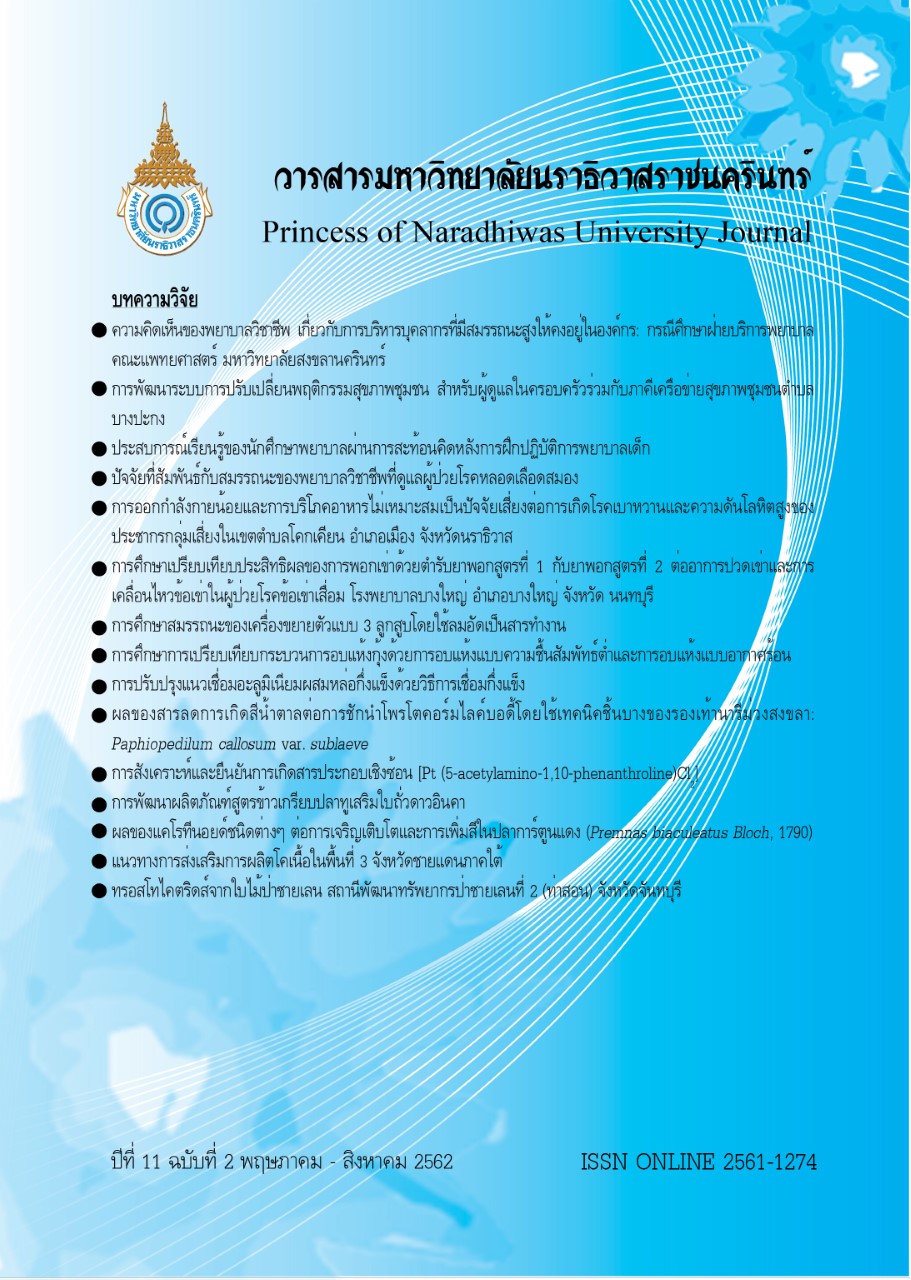ปัจจัยทำนายความรุนแรงที่เกิดจากคู่สมรสในสตรีตั้งครรภ์ที่เป็นโรคติดเชื้อทางเพศสัมพันธ์
Factors Predicting Intimate Partner Violence among Pregnant Women with Sexually Transmitted Infections
คำสำคัญ:
ความรุนแรงที่เกิดจากคู่สมรส, สตรีตั้งครรภ์, โรคติดเชื้อทางเพศสัมพันธ์, ปัจจัยทำานายบทคัดย่อ
การวิจัยครั้งนี้ใช้รูปแบบหาความสัมพันธ์เชิงทำนาย มีวัตถุประสงค์เพื่อศึกษาอำนาจการทำนายของการเป็นโรคติดเชื้อทางเพศสัมพันธ์ อายุครรภ์ที่มาฝากครรภ์ครั้งแรก อายุที่มีเพศสัมพันธ์ครั้งแรก การใช้ถุงยางอนามัย การดื่มแอลกอฮอล์ของสามี และการสนับสนุนทางสังคมต่อความรุนแรงที่เกิดจากคู่สมรสในสตรีตั้งครรภ์ที่เป็นโรคติดเชื้อทางเพศสัมพันธ์ กลุ่มตัวอย่างเป็นสตรีตั้งครรภ์ที่เป็นโรคติดเชื้อทางเพศสัมพันธ์จำนวน 180 ราย ที่เข้ารับการตรวจในหน่วยโรคติดเชื้อทางนรีเวชและโรคติดต่อทางเพศสัมพันธ์สตรี ณ โรงพยาบาลมหาวิทยาลัยในเขตกรุงเทพมหานคร เก็บรวบรวมข้อมูลโดยใช้แบบสอบถาม 6 ชุด ได้แก่ 1) ข้อมูลส่วนบุคคล 2) การมีเพศสัมพันธ์ 3) การตั้งครรภ์ 4) การใช้สารเสพติด 5) การสนับสนุนทางสังคม และ 6) แบบคัดกรองความรุนแรง ตรวจสอบความตรงเชิงเนื้อหาของเครื่องมือทั้งหมดโดยผู้ทรงคุณวุฒิจำนวน 3 ท่าน ทดสอบค่าความเที่ยงของเครื่องมือชุดที่ 5 และ 6 ได้ค่าสัมประสิทธิ์แอลฟาของครอนบาคเท่ากับ .97, .78 ตามลำดับ วิเคราะห์ข้อมูลโดยใช้สถิติเชิงพรรณนา ไคสแควร์ ทดสอบค่าที และถดถอยโลจิสติกส์การวิจัยครั้งนี้ใช้รูปแบบหาความสัมพันธ์เชิงทำนาย มีวัตถุประสงค์เพื่อศึกษาอำนาจการทำนายของการเป็นโรคติดเชื้อทางเพศสัมพันธ์ อายุครรภ์ที่มาฝากครรภ์ครั้งแรก อายุที่มีเพศสัมพันธ์ครั้งแรก การใช้ถุงยางอนามัย การดื่มแอลกอฮอล์ของสามี และการสนับสนุนทางสังคมต่อความรุนแรงที่เกิดจากคู่สมรสในสตรีตั้งครรภ์ที่เป็นโรคติดเชื้อทางเพศสัมพันธ์ กลุ่มตัวอย่างเป็นสตรีตั้งครรภ์ที่เป็นโรคติดเชื้อทางเพศสัมพันธ์จำนวน 180 ราย ที่เข้ารับการตรวจในหน่วยโรคติดเชื้อทางนรีเวชและโรคติดต่อทางเพศสัมพันธ์สตรี ณ โรงพยาบาลมหาวิทยาลัยในเขตกรุงเทพมหานคร เก็บรวบรวมข้อมูลโดยใช้แบบสอบถาม 6 ชุด ได้แก่ 1) ข้อมูลส่วนบุคคล 2) การมีเพศสัมพันธ์ 3) การตั้งครรภ์ 4) การใช้สารเสพติด 5) การสนับสนุนทางสังคม และ 6) แบบคัดกรองความรุนแรง ตรวจสอบความตรงเชิงเนื้อหาของเครื่องมือทั้งหมดโดยผู้ทรงคุณวุฒิจำนวน 3 ท่าน ทดสอบค่าความเที่ยงของเครื่องมือชุดที่ 5 และ 6 ได้ค่าสัมประสิทธิ์แอลฟาของครอนบาคเท่ากับ .97, .78 ตามลำดับ วิเคราะห์ข้อมูลโดยใช้สถิติเชิงพรรณนา ไคสแควร์ ทดสอบค่าที และถดถอยโลจิสติกส์ ผลการวิจัยพบว่า กลุ่มตัวอย่างร้อยละ 29.4 ได้รับความรุนแรงที่เกิดจากคู่สมรส ปัจจัยทั้ง 5 ตัวสามารถร่วมกันทำนายความรุนแรงได้ร้อยละ 78 (Nagelkerke R2 = .78, p < .05) โดยอายุครรภ์ที่มาฝากครรภ์ครั้งแรก (OR = 5.20, p < .05) อายุที่มีเพศสัมพันธ์ครั้งแรก (OR = 7.68, p < .05) การใช้ถุงยางอนามัย (OR = 3.52, p < .05) การดื่มแอลกอฮอล์ของสามี (OR = 4.58, p < .05) และการสนับสนุนทางสังคม (OR = .85, p < .05) สามารถทำนายความรุนแรงได้อย่างมีนัยสำคัญทางสถิติ ผลการวิจัยครั้งนี้นำมาใช้เป็นแนวทางในการคัดกรองปัจจัยเสี่ยงร่วมกับความรุนแรงที่เกิดจากคู่สมรสและใช้เป็นข้อมูลพื้นฐานสำหรับการวิจัยเกี่ยวกับความรุนแรงในสตรีตั้งครรภ์ที่เป็นโรคติดเชื้อทางเพศสัมพันธ์ต่อไป
เอกสารอ้างอิง
Bureau of Epidemiology, Department of Disease Control Ministry of Public Health. (2014). Prevalence and incidence of HIV infection in Thailand, 2013. Nonthaburi: Epidemiological surveillance system for AIDS, tuberculosis and STDs. Ministry of Public Health. (in Thai)
Burgos-Soto, J., Orne-Gliemann, J., Encrenaz, G., Patassi, A., Woronowski, A., Kariyiare, B., et al. (2014). Intimate partner sexual and physical violence among women in Togo, West Africa: Prevalence, associated factors, and the specific role of HIV infection. Global Health Action, 26(7), 1-14.
Chaiphosri, P., Ninsum, K., Mahathamnuchock, N., Sripilas, S., & Srilamjiak, K. (2016). HIV Prevention Surveillance in Bangkok Area, 2015. Bangkok: Control division of AIDS, Tuberculosis and STIs Department of Health. (in Thai)
Dhakal, L., Berg-Beckhoff, G., & Aro, A. R. (2014). Intimate partner violence (physical and sexual) and sexually transmitted infection: Results from Nepal demographic health survey 2011. International Journal of Women's Health, 6, 75-82.
Diaz-Olavarrieta, C., Wilson, K. S., Garcia, S. G., Revollo, R., Richmond, K., Paz, F., et al. (2009). The co-occurrence of intimate partner violence and syphilis among pregnant women in Bolivia. Journal of Women's Health, 18(12), 2077-2086.
Dude, A. M. (2011). Spousal intimate partner violence is associated with HIV and other STIs among married Rwandan women. AIDS and Behavior, 15(1), 142-152.
Han, A., & Stewart, D. E. (2014). Maternal and fetal outcomes of intimate partner violence associated with pregnancy in the Latin American and Caribbean region. International Journal of Gynecology & Obstetrics, 124(1), 6-11.
Ibrahim, Z. M., Ahmed, W. S., El-Hamid, S. A., & Hagras, A. M. (2015). Intimate partner violence among Egyptian pregnant women: Incidence risk factors and adverse maternal and fetal outcomes. Clinical and Experimental Obstetrics & Gynecology, 42(2), 213-219.
Jackson, C. L., Ciciolla, L., Crnic, K. A., Luecken, L. J., Gonzales, N. A., & Coonrod, D. V. (2015). Intimate partner violence before and during pregnancy related demographic and psychosocial factors and postpartum depressive symptoms among Mexican American women. Journal of Interpersonal Violence, 30(4), 659-679.
Makayoto, L. A., Omolo, J., Kamweya, A. M., Harder, V. S., & Mutai, J. (2013). Prevalence and associated factors of intimate partner violence among pregnant women attending Kisumu District Hospital, Kenya. Maternal and Child Health Journal, 17(3), 441-447.
McFarlane, J., Parker, B., Soeken, K., & Bullock, L. (1992). Assessing for abuse during pregnancy: Severity and frequency of injuries and associated entry into prenatal care. Journal of American Medical Association, 267(23), 3176-3178.
Ntaganira, J., Muula, A. S., Masaisa, F., Dusabeyezu, F., Siziya, S., & Rudatsikira, E. (2008). Intimate partner violence among pregnant women in Rwanda. BioMed Central Women's Health, 8(1), 17-24.
Olagbuji, B., Ezeanochie, M., Ande, A., & Ekaete, E. (2010). Trends and determinants of pregnancy-related domestic violence in a referral center in southern Nigeria. International Journal of Gynecology & Obstetrics, 108(2), 101-103.
Perales, M. T., Cripe, S. M., Lam, N., Sanchez, S. E., Sanchez, E., & Williams, M. A. (2009). Prevalence, types, and pattern of intimate partner violence among pregnant women in Lima, Peru. Violence Against Women, 15(2), 224-250.
Polit, D.F., & Hungler, B.P. (1995). Nursing research: Principles and methods. (5thed.). Philadelphia: J.B. Lippincott.
Rungruangsiripan, M., Sitthimongkol, Y., Maneesriwongul, W., Talley, S., & Vorapongsathorn, T. (2011). Mediating role of illness representation among social support, therapeutic alliance, experience of medication side effects and medication adherence in persons with schizophrenia. Archives of Psychiatric Nursing, 25(4), 269-283.
Shamu, S., Abrahams, N., Temmerman, M., Musekiwa, A., & Zarowsky, C. (2011). A systematic review of African studies on intimate partner violence against pregnant women: Prevalence and risk factors. Public Library of Science, 6(3), 1-9.
Shamu, S., Abrahams, N., Zarowsky, C., Shefer, T., & Temmerman, M. (2013). Intimate partner violence during pregnancy in Zimbabwe: A cross-sectional study of prevalence, predictors and associations with HIV. Tropical Medicine & International Health, 18(6), 696-711.
Shamu, S., Zarowsky, C., Shefer, T., Temmerman, M., & Abrahams, N. (2014). Intimate partner violence after disclosure of HIV test results among pregnant women in Harare, Zimbabwe. Public Library of Science, 9(10), 1-8.
Sherbourne, C. D., & Stewart, A. L. (1991). The MOS social support surveys. Social Science & Medicine, 32(6), 705-714.
Sigalla, G. N., Rasch, V., Gammeltoft, T., Meyrowitsch, D. W., Rogathi, J., Manongi, R., et al. (2017). Social support and intimate partner violence during pregnancy among women attending antenatal care in Moshi Municipality, Northern Tanzania. BioMed Central Public Health, 17(1), 240-252.
Taillieu, T. L., & Brownridge, D. A. (2010). Violence against pregnant women: Prevalence, patterns, risk factors, theories, and directions for future research. Aggression and Violent Behavior, 15(1), 14-35.
Thananowan, N. (2004). Intimate partner violence (IPV) among Thai pregnant women: The correlation of violence with maternal characteristics, health care practices during pregnancy, and maternal health. Unpublished Doctoral issertation, University of Wisconsin-Madison, USA.
Thananowan, N. (2014). Violence against Women: Analysis and conclusions of the research evidence. Bangkok: V. print (1991) Co., Ltd. (in Thai)
Thananowan, N., & Heidrich, S. M. (2008). Intimate partner violence among pregnant Thai women. Violence Against Women, 14(5), 509-527.
United Nations Programme on HIV/AIDS. (2015). Guidelines for conducting HIV surveillance among pregnant women attending antenatal clinics based on routine programm data. Retrieved from https://www.unaids.org/sites/default/files/media_asset/SurveillanceRoutineProgramme Data_en.pdf.




